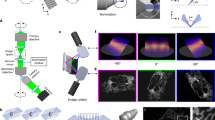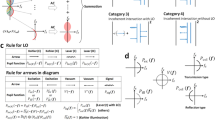Abstract
The resolution of far-field optical microscopy stagnated for a century, but a quest began in the 1990s leading to nanoscale imaging of transparent fluorescent objects in three dimensions. Important elements in this pursuit were the synthesis of the aperture of two opposing lenses and the modulation or switching of the fluorescence of adjacent markers. The first element provided nearly isotropic three-dimensional resolution by improving the axial resolution by three- to sevenfold, and the second enabled the diffraction barrier to be overcome. Here, we review recent progress in the synergistic combination of these two elements which non-invasively provide an isotropic diffraction-unlimited three-dimensional resolution in transparent objects.
This is a preview of subscription content, access via your institution
Access options
Subscribe to this journal
Receive 12 print issues and online access
$209.00 per year
only $17.42 per issue
Buy this article
- Purchase on Springer Link
- Instant access to full article PDF
Prices may be subject to local taxes which are calculated during checkout






Similar content being viewed by others
References
Born, M. & Wolf, E. Principles of Optics 7th edn (Cambridge University Press, 2002).
Alberts, B. et al. Molecular Biology of the Cell 4th edn (Garland Science, 2002).
Pohl, D. W., Denk, W. & Lanz, M. Optical stethoscopy: Image recording with resolution λ/20. Appl. Phys. Lett. 44, 651–653 (1984).
Lewis, A., Isaacson, M., Harootunian, A. & Murray, A. Development of a 500 A resolution light microscope. Ultramicroscopy 13, 227–231 (1984).
Novotny, L. & Hecht, B. Principles of nano-optics (Cambridge University Press, 2006).
Kawata, S. Inouye, Y., & Verma, P. Plasmonics for near-field nano-imaging and superlensing. Nature Photon. 3, 388–394 (2009).
Pendry, J. B. Negative refraction makes a perfect lens. Phys. Rev. Lett. 85, 3966–3969 (2000).
Hell, S. W. & Wichmann, J. Breaking the diffraction resolution limit by stimulated emission: stimulated emission depletion fluorescence microscopy. Opt. Lett. 19, 780–782 (1994).
Hell, S. W. & Kroug, M. Ground-state depletion fluorescence microscopy, a concept for breaking the diffraction resolution limit. Appl. Phys. B 60, 495–497 (1995).
Hell, S. W. in Topics in Fluorescence Spectroscopy Vol. 5 (ed. J. R. Lakowicz) 361–422 (Plenum Press, 1997).
Klar, T. A., Jakobs, S., Dyba, M., Egner, A. & Hell, S. W. Fluorescence microscopy with diffraction resolution limit broken by stimulated emission. Proc. Natl Acad. Sci. USA 97, 8206–8210 (2000).
Dyba, M. & Hell, S. W. Focal spots of size λ/23 open up far-field fluorescence microscopy at 33 nm axial resolution. Phys. Rev. Lett. 88, 163901 (2002).
Hell, S. W. Toward fluorescence nanoscopy. Nature Biotechnol. 21, 1347–1355 (2003).
Heintzmann, R., Jovin, T. M. & Cremer, C. Saturated patterned excitation microscopy — A concept for optical resolution improvement. J. Opt. Soc. Am. A 19, 1599–1609 (2002).
Gustafsson, M. G. L. Nonlinear structured-illumination microscopy: Wide-field fluorescence imaging with theoretically unlimited resolution. Proc. Natl Acad. Sci. USA 102, 13081–13086 (2005).
Willig, K. I., Rizzoli, S. O., Westphal, V., Jahn, R. & Hell, S. W. STED-microscopy reveals that synaptotagmin remains clustered after synaptic vesicle exocytosis. Nature 440, 935–939 (2006).
Betzig, E. et al. Imaging intracellular fluorescent proteins at nanometer resolution. Science 313, 1642–1645 (2006).
Rust, M. J., Bates, M. & Zhuang, X. Sub-diffraction-limit imaging by stochastic optical reconstruction microscopy (STORM). Nature Meth. 3, 793–796 (2006).
Hess, S. T., Girirajan, T. P. K. & Mason, M. D. Ultra-high resolution imaging by fluorescence photoactivation localization microscopy. Biophys. J. 91, 4258–4272 (2006).
Egner, A. et al. Fluorescence nanoscopy in whole cells by asnychronous localization of photoswitching emitters. Biophys. J. 93, 3285–3290 (2007).
Hell, S. W. Double-scanning confocal microscope. European patent 0491289 (1990/1992).
Hell, S. & Stelzer, E. H. K. Properties of a 4Pi-confocal fluorescence microscope. J. Opt. Soc. Am. A 9, 2159–2166 (1992).
Gustafsson, M. G. L., Agard, D. A. & Sedat, J. W. Sevenfold improvement of axial resolution in 3D widefield microscopy using two objective lenses. Proc. SPIE 2412, 147–156 (1995).
Hell, S. W., Schrader, M. & van der Voort, H. T. M. Far-field fluorescence microscopy with three-dimensional resolution in the 100 nm range. J. Microsc. 185, 1–5 (1997).
Gustafsson, M. G. L., Agard, D. A. & Sedat, J. W. I5M: 3D widefield light microscopy with better than 100 nm axial resolution. J. Microsc. 195, 10–16 (1999).
Shao, L. et al. I5S: Wide-field light microscopy with 100 nm scale resolution in three dimensions. Biophys. J. 94, 4971–4983 (2008).
Hell, S. W. Far-field optical nanoscopy. Science 316, 1153–1158 (2007).
Gugel, H. et al. Cooperative 4Pi excitation and detection yields 7-fold sharper optical sections in live cell microscopy. Biophys. J. 87, 4146–4152 (2004).
Bewersdorf, J., Bennett, B. T. & Knight, K. L. H2AX chromatin structures and their response to DNA damage revealed by 4Pi microscopy. Proc. Natl Acad. Sci. USA 103, 18137–18142 (2006).
Gustafsson, M. G. L. & Clarke, J. Scanning force microscope springs optimized for optical-beam deflection and with tips made by controlled fracture. J. Appl. Phys. 76, 172–181 (1994).
Hofmann, M., Eggeling, C., Jakobs, S. & Hell, S. W. Breaking the diffraction barrier in fluorescence microscopy at low light intensities by using reversibly photoswitchable proteins. Proc. Natl Acad. Sci. USA 102, 17565–17569 (2005).
Sharonov, A. & Hochstrasser, R. M. Wide-field subdiffraction imaging by accumulated binding of diffusing probes. Proc. Natl Acad. Sci. USA 103, 18911–18916 (2006).
Shroff, H. et al. Dual-color superresolution imaging of genetically expressed probes within individual adhesion complexes. Proc. Natl Acad. Sci. USA 104, 20308–20313 (2007).
Juette, M. F. et al. Three-dimensional sub-100 nm resolution fluorescence microscopy of thick samples. Nature Meth. 5, 527–529 (2008).
Bates, M., Huang, B., Dempsey, G. P. & Zhuang, X. Multicolor super-resolution imaging with photo-switchable fluorescent probes. Science 317, 1749–1753 (2007).
Zhuang, X. Nano-imaging with STORM. Nature Photon. 3, 365–367 (2009).
Rittweger, E., Wildanger, D. & Hell, S. W. Far-field fluorescence nanoscopy of diamond color centers by ground state depletion. Europhys. Lett. 86, 14001–14006 (2009).
Biteen, J. S. et al. Super-resolution imaging in live caulobacter crescentus cells using photoswitchable EYFP. Nature Meth. 5, 947–949 (2008).
Pavani, S. R. P. et al. Three-dimensional, single-molecule fluorescence imaging beyond the diffraction limit by using a double-helix point spread function. Proc. Natl Acad. Sci. USA 106, 2995–2999 (2009).
van de Linde, S., Kasper, R., Heilemann, M. & Sauer, M. Photoswitching microscopy with standard fluorophores. Appl. Phys. B 93, 725–731 (2008).
Heilemann, M. et al. Subdiffraction-resolution fluorescence imaging with conventional fluorescent probes. Angew. Chem. Int. Ed. 47, 6172–6176 (2008).
Dyba, M., Jakobs, S. & Hell, S. W. Immunofluorescence stimulated emission depletion microscopy. Nature Biotechnol. 21, 1303–1304 (2003).
Middendorff, C.v., Egner, A., Geisler, C., Hell, S. W. & Schönle, A. Isotropic 3D nanoscopy based on single emitter switching. Opt. Express 16, 20774–20788 (2008).
Shtengel, G. et al. Interferometric fluorescent super-resolution microscopy resolves 3D cellular ultrastructure. Proc. Natl Acad. Sci. USA 106, 3125–3130 (2009).
Schmidt, R. et al. Spherical nanosized focal spot unravels the interior of cells. Nature Meth. 5, 539–544 (2008).
Lemmer, P. et al. SPDM — Light microscopy with single molecule resolution at the nanoscale. Appl. Phys. B 93, 1–12 (2008).
Egner, A., Schrader, M. & Hell, S. W. Refractive index mismatch induced intensity and phase variations in fluorescence confocal, multiphoton and 4Pi- microscopy. Opt. Commun. 153, 211–217 (1998).
Ullal, C. K., Schmidt, R., Hell, S. W. & Egner, A. Block copolymer nanostructures mapped by far-field optics. Nano Lett. 9, 2497–2500 (2009).
Schmidt, R. et al. Mitochondrial cristae revealed with focused light. Nano Lett. 9, 2508–2510 (2009).
Harke, B., Ullal, C. K., Keller, J. & Hell, S. W. Three-dimensional nanoscopy of colloidal crystals. Nano Lett. 8, 1309–1313 (2008).
Huang, B., Wang, W., Bates, M. & Zhuang, X. Three-dimensional super-resolution imaging by stochastic optical reconstruction microscopy. Science 319, 810–813 (2008).
Huang, B., Jones, S. A., Brandenburg, B. & Zhuang, X. Whole-cell 3D STORM reveals interactions between cellular structures with nanometer-scale resolution. Nature Meth. 5, 1047–1052 (2008).
Acknowledgements
Substantial contributions to the isoSTED imaging applications reviewed in this paper are from Chaitanya Ullal (block co-polymers), as well as Christian Wurm and Stefan Jakobs (mitochondria). We also thank Andreas Schönle, Claas v. Middendorf, and Jan Keller for helpful discussions and Jaydev Jethwa for critical reading. This work was supported by grants of the Deutsche Forschungsgemeinschaft to A.E. and S.W.H (SFB 755).
Author information
Authors and Affiliations
Corresponding author
Rights and permissions
About this article
Cite this article
Hell, S., Schmidt, R. & Egner, A. Diffraction-unlimited three-dimensional optical nanoscopy with opposing lenses. Nature Photon 3, 381–387 (2009). https://doi.org/10.1038/nphoton.2009.112
Issue Date:
DOI: https://doi.org/10.1038/nphoton.2009.112
This article is cited by
-
Graphene- and metal-induced energy transfer for single-molecule imaging and live-cell nanoscopy with (sub)-nanometer axial resolution
Nature Protocols (2021)
-
Super-resolution fluorescence microscopy studies of human immunodeficiency virus
Retrovirology (2018)
-
X-ray ptychography
Nature Photonics (2018)
-
Single-molecule fluorescence imaging: Generating insights into molecular interactions in virology
Journal of Biosciences (2018)
-
4Pi-RESOLFT nanoscopy
Nature Communications (2016)



